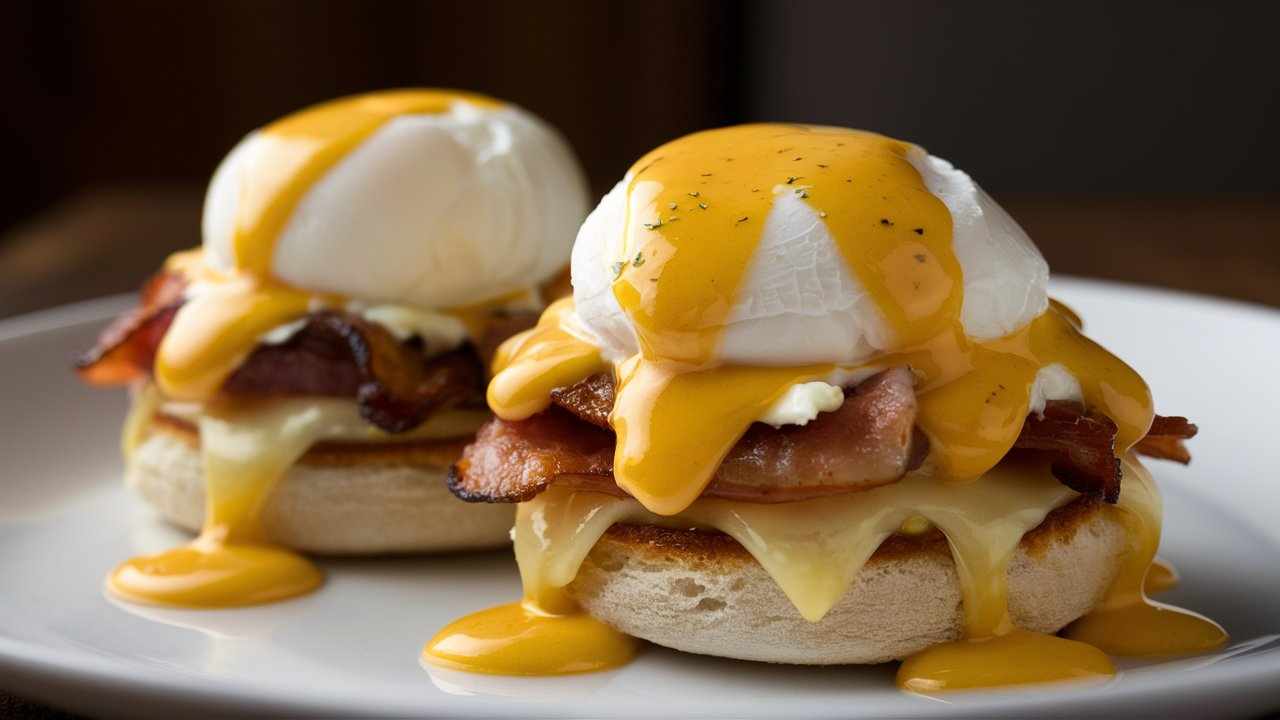As a professional cook , I’ve mastered the art of creating this brunch favorite at home. While it may seem daunting at first, with the right techniques and a bit of practice, you too can whip up restaurant-quality Eggs Benedict in your own kitchen. So, let’s dive into the delicious breakfast!

Ingredients Needed for Making Eggs Benedict (Serves 4)
You’ll need the following ingredients:
- 4 large eggs (preferably fresh and high-quality)
- 2 English muffins, halved horizontally
- 8 slices of Canadian bacon or thinly sliced ham
- 1 tbsp white vinegar (for poaching the eggs)
- Unsalted butter (for toasting the English muffins)
- Salt and pepper (to taste)
For the Hollandaise Sauce:
- 4 large egg yolks
- 1/2 cup unsalted butter, melted
- 2 tbsp lemon juice (freshly squeezed)
- 1/4 tsp cayenne pepper (or to taste)
- Salt and pepper (to taste)
Timing
| Preparation Time | Cooking Time | Total Time |
| 15 minutes | 25 minutes | 40 minutes |
How to Make Eggs Benedict: Step-by-Step
Step 1- Begin by preheating your oven to 200°F (93°C). This will keep your prepared components warm while you assemble the dish.
Step 2- Bring a large saucepan filled with water and 1 tbsp of white vinegar to a gentle simmer over medium heat. This will be used for poaching the eggs later.
Step 3- In a small saucepan, melt the unsalted butter over low heat. Once melted, set it aside to cool slightly.
Poaching Eggs and Assembling the Dish
-
Crack each egg individually into a small ramekin or cup. Gently slide the eggs, one at a time, into the simmering water.
-
Poach the eggs for about 4-5 minutes, or until the whites are completely set, and the yolks are still runny.
-
While the eggs are poaching, toast the English muffin halves in a skillet or toaster oven until golden brown. Spread a thin layer of butter on the toasted muffin halves.
-
In the same skillet, cook the Canadian bacon or ham slices until lightly browned and heated through.
-
Once the eggs are poached, use a slotted spoon to carefully remove them from the water, allowing any excess water to drain off.
-
Place a toasted English muffin half on each plate, followed by a slice or two of Canadian bacon or ham.
-
Top each muffin half with a poached egg, and generously drizzle the warm hollandaise sauce over the top.
-
Garnish with a sprinkle of cayenne pepper or paprika, and serve immediately.

Tips for Poaching Eggs Perfectly and Assembling Eggs Benedict
- Use fresh, high-quality eggs for best results. Older eggs tend to spread more in the poaching water.
- Add a splash of vinegar to the poaching water. This helps the egg whites hold their shape.
- Swirl the poaching water gently before adding the eggs to create a gentle vortex, which will help the egg whites wrap around the yolk.
- Drain the poached eggs on a paper towel-lined plate to remove any excess water before assembling.
- Assemble the Eggs Benedict components quickly to ensure everything stays warm and the yolks remain runny.
Making Homemade Hollandaise Sauce
While you can purchase pre-made hollandaise sauce, nothing beats the rich, velvety texture and robust flavor of a homemade version:
-
In a small saucepan, whisk together the egg yolks, lemon juice, cayenne pepper, and a pinch of salt and pepper.
-
Place the saucepan over low heat and whisk continuously.
-
Slowly drizzle in the melted butter, whisking constantly, until the mixture thickens and emulsifies.
-
Remove the saucepan from heat and continue whisking for another minute or two.
-
Taste and adjust seasoning with salt, pepper, or lemon juice as desired.
-
Keep the hollandaise sauce warm until ready to serve by placing the saucepan in a water bath or using a double boiler.
Tips for Serving and Presentation
-
Serve Eggs Benedict immediately after assembling to ensure the hollandaise sauce remains warm and velvety, and the egg yolks are still runny.
-
Garnish with fresh herbs like chives, parsley, or dill for a pop of color and added flavor.
-
Consider plating the components separately and allowing your guests to assemble their own Eggs Benedict for a fun, interactive experience.
-
Use a squeeze bottle or piping bag to drizzle the hollandaise sauce over the poached eggs for a professional, restaurant-style presentation.
-
Accompany your Eggs Benedict with fresh fruit, roasted potatoes, or a crisp green salad for a well-rounded brunch experience.
Variations and Substitutions
-
Vegetarian Option: Swap the Canadian bacon or ham for sautéed spinach, roasted tomatoes, or grilled portobello mushrooms.
-
Seafood Twist: Replace the meat with smoked salmon, crab cakes, or sautéed shrimp for a delightful seafood spin.
-
Gluten-Free Alternative: Substitute the English muffins with gluten-free bread or hash brown patties for a gluten-free version.
Ideas for Customizing Eggs Benedict with Different Ingredients
- Add avocado slices or guacamole for a creamy, nutrient-rich twist.
- Incorporate sautéed bell peppers, onions, or mushrooms for extra flavor and texture.
- Experiment with different types of cheese, such as cheddar, goat cheese, or feta, for a unique spin on the classic.
- Incorporate smoked or cured meats like prosciutto, chorizo, or pancetta for a bold, savory kick.
- Elevate the dish with truffle oil or shaved truffles for an indulgent, luxurious touch.
Nutritional Facts
Amount Per Serving
- Calories: 548
- Total Fat: 41g
- Saturated Fat: 20g
- Cholesterol: 421mg
- Sodium: 926mg
- Total Carbohydrates: 19g
- Dietary Fiber: 1g
- Protein: 24g
Conclusion
Crafting the perfect Eggs Benedict at home may seem like a daunting task, but with the right techniques and a little practice, you’ll be able to impress your loved ones with this brunch classic. From perfectly poached eggs to a rich, velvety hollandaise sauce, every component contributes to the overall deliciousness of this dish.
Remember, the key to success lies in using high-quality ingredients, mastering the art of poaching eggs, and paying close attention to the details. With a little patience and a willingness to experiment, you’ll soon be serving up restaurant-quality Eggs Benedict that will have your guests coming back for more.
FAQs
1- Can I make Eggs Benedict ahead of time?
While it’s best to assemble and serve Eggs Benedict immediately, you can prepare some components in advance. Poach the eggs and store them in an airtight container in the refrigerator for up to 5 days. Reheat them gently in hot water before assembling. The hollandaise sauce can be made a day ahead and reheated gently, adding a splash of water if needed to thin it out.
2- How do I prevent the hollandaise sauce from separating?
To prevent the hollandaise sauce from separating, ensure that you whisk the egg yolks continuously while slowly drizzling in the melted butter. Also, avoid overheating the sauce, as this can cause the eggs to scramble and the emulsion to break.
3- Can I use something other than English muffins?
Absolutely! While English muffins are traditional, you can substitute them with toasted bagels, biscuits, or even crispy hash brown patties for a gluten-free option.
4- How do I know when the eggs are perfectly poached?
Perfectly poached eggs should have a firm white and a runny yolk. The whites should be completely opaque, with no translucent or raw parts remaining. The yolks should still be soft and liquid when gently pressed.
5- Can I make Eggs Benedict without hollandaise sauce?
While hollandaise sauce is a integral part of Eggs Benedict, you can substitute it with other flavorful sauces or toppings. Some alternatives include béarnaise sauce, salsa, pesto, or even a drizzle of truffle oil or balsamic glaze.
Remember, the beauty of Eggs Benedict lies in its versatility and your ability to put your own spin on this classic dish. So, don’t be afraid to experiment and let your culinary creativity shine through!